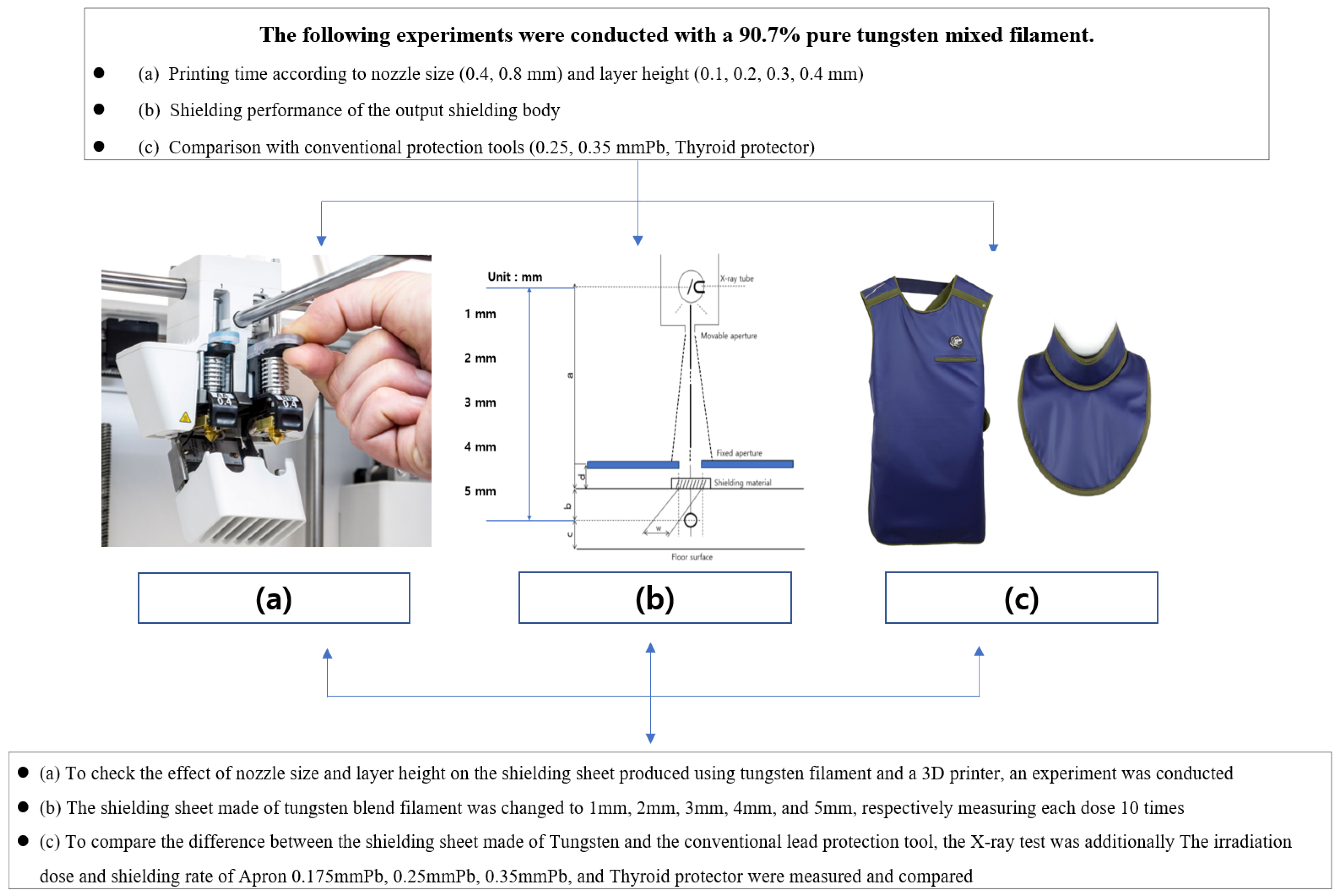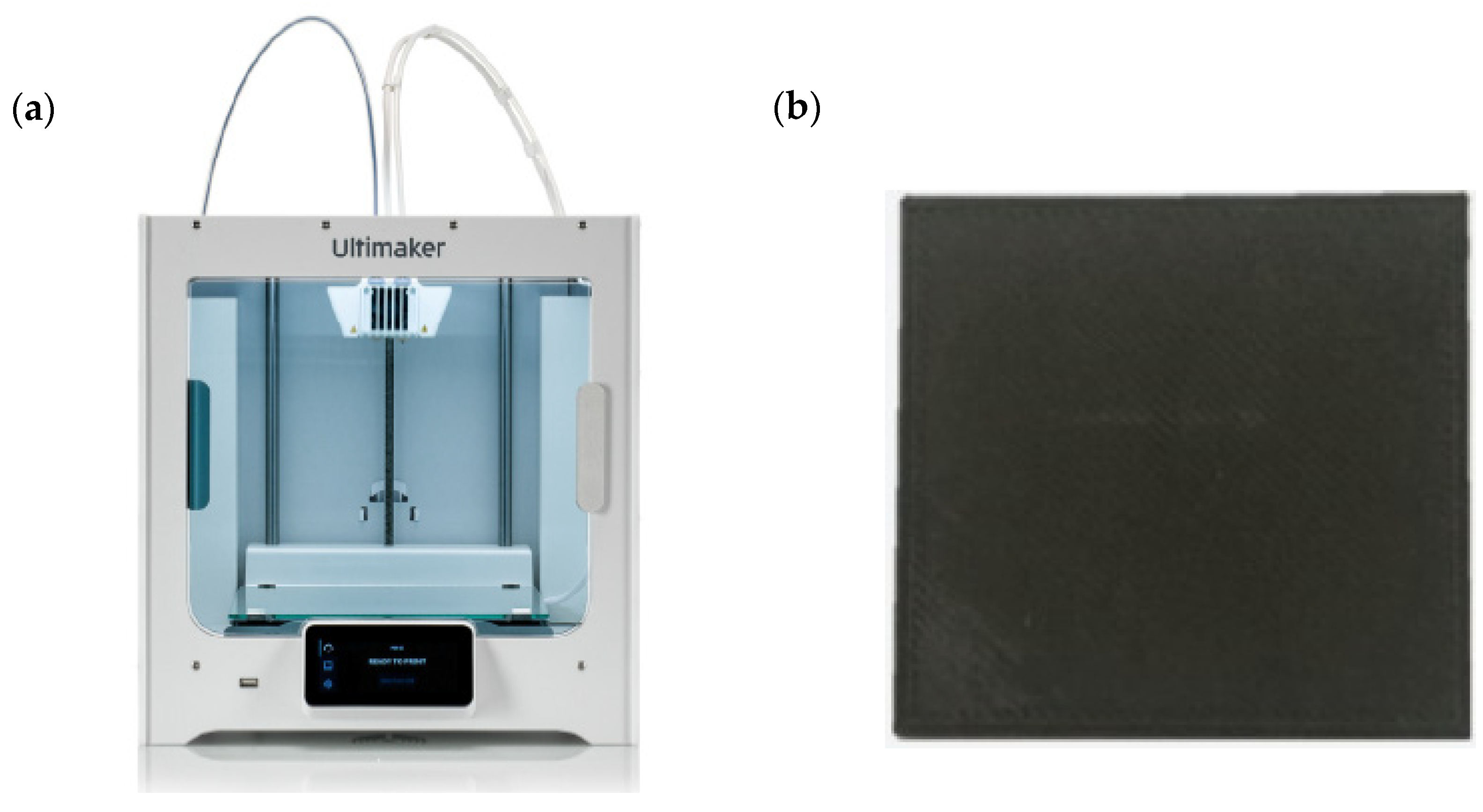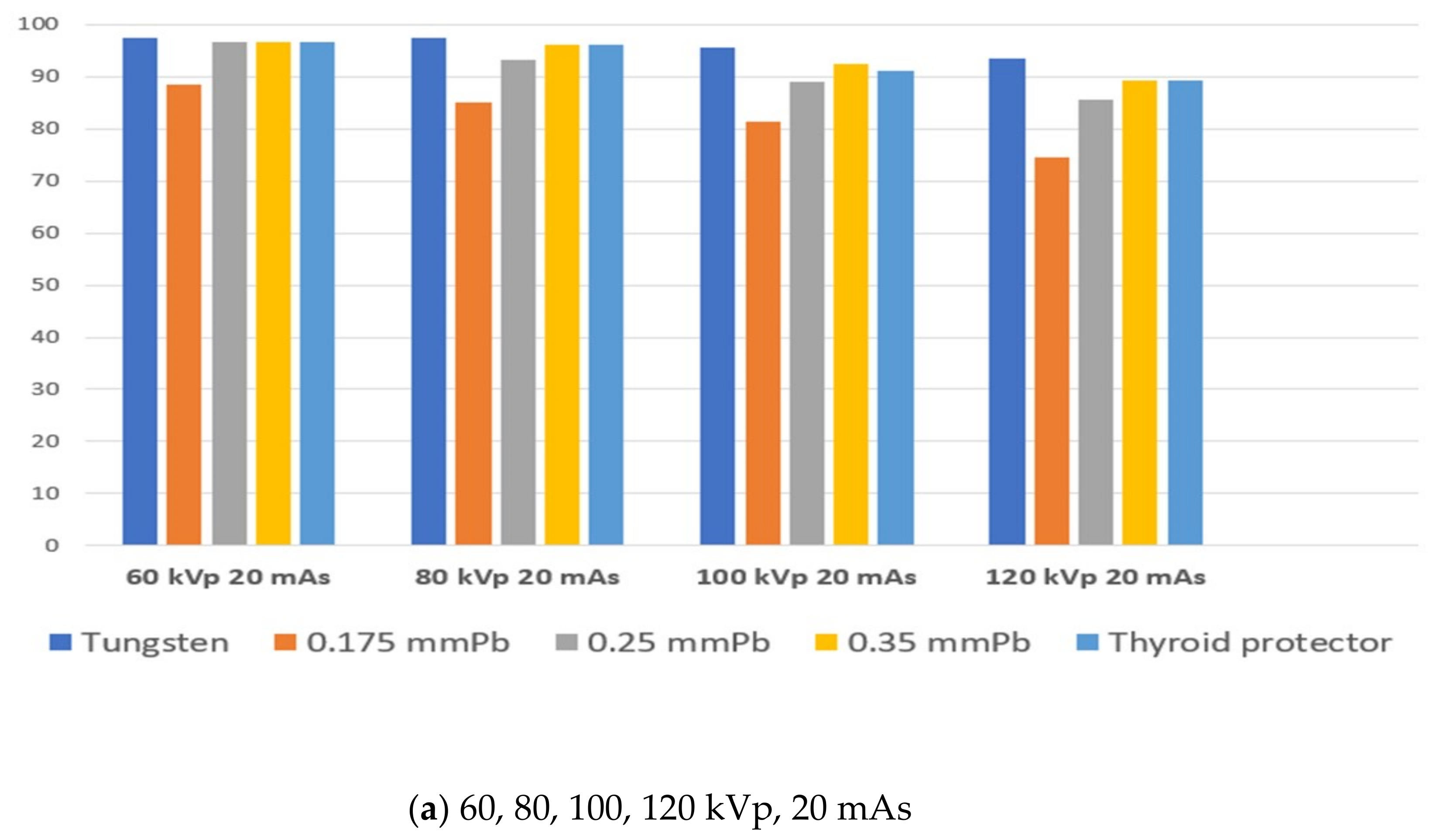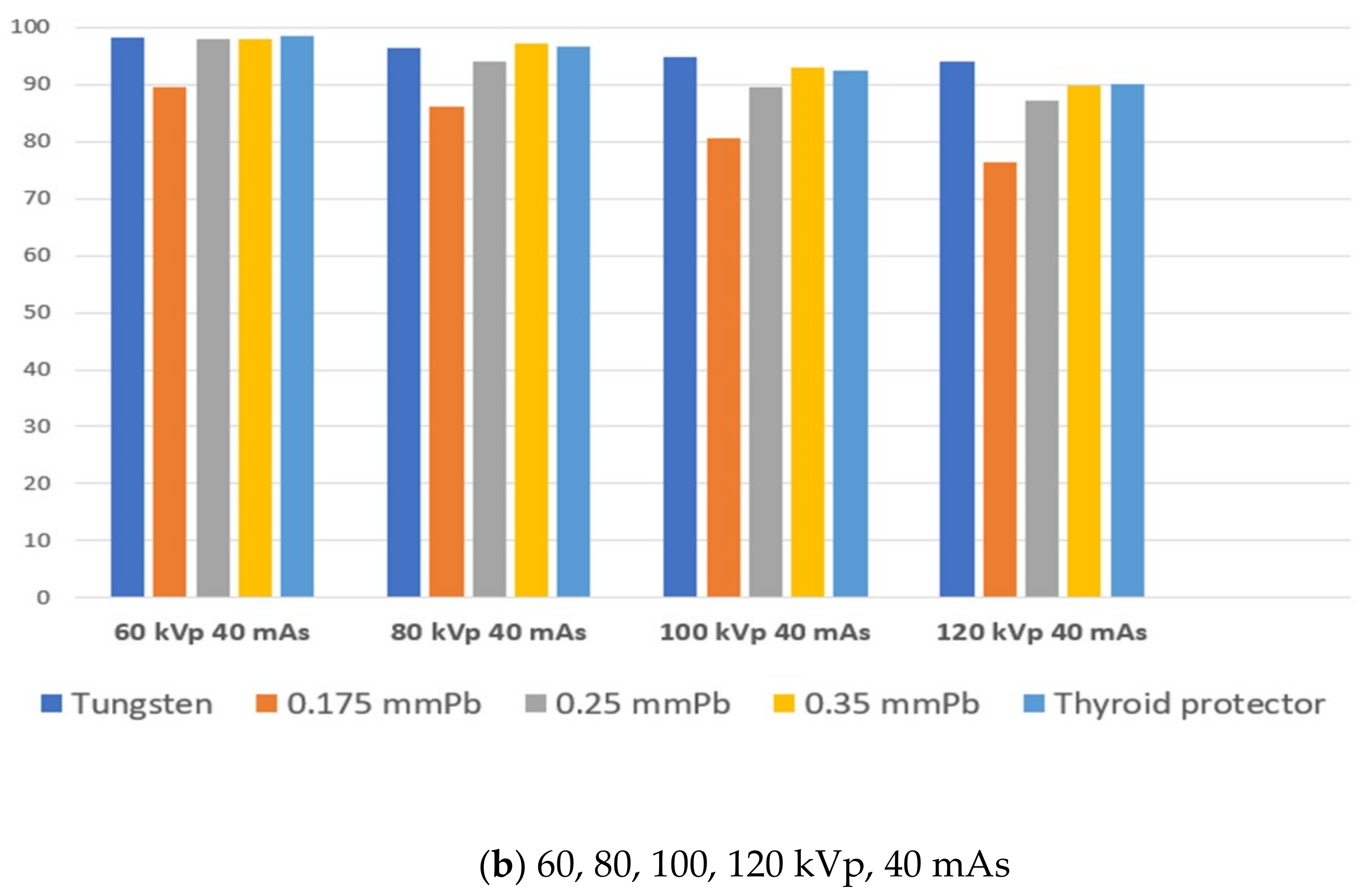Influence of Parameters and Performance Evaluation of 3D-Printed Tungsten Mixed Filament Shields
Abstract
1. Introduction
2. Materials and Methods
2.1. Using 3D Printer and Tungsten Mixed Filament Shielding Sheet Fabrication
2.2. Setting the Output Variable and Converting the G-Code
2.3. The 3D Printing Output and Shielding Sheet Production
3. X-ray Dosimetry
3.1. Dosimetry in X-rays
3.2. Shielding Rate Test Using Shielding Sheet
3.3. Dosimetry of Lead Protective Tools
4. Results
4.1. Dosimetry of X-rays
4.1.1. Shielding Sheet Printing Time
4.1.2. Evaluating the Measured Dose and Shielding Rate
4.1.3. X-ray Dose Measurement and Evaluation of Shielding Rate
4.1.4. Comparison of the Shielding Rate between Lead Protective Tools and Shielding Sheets
5. Discussion
6. Conclusions
Author Contributions
Funding
Institutional Review Board Statement
Informed Consent Statement
Data Availability Statement
Conflicts of Interest
References
- Buys, D.G.; Brown, S.C. Radiation exposure protection: Small things matter. Cardiovasc. J. Afr. 2021, 32, 5–6. [Google Scholar] [CrossRef] [PubMed]
- Martin, C.J. Radiation shielding for diagnostic radiology. Radiat. Prot. Dosim. 2015, 165, 376–381. [Google Scholar] [CrossRef] [PubMed]
- Mori, H.; Koshida, K.; Ishigamori, O.; Matsubara, K. Evaluation of the effectiveness of X-ray protective aprons in experimental and practical fields. Radiol. Phys. Technol. 2013, 7, 158–166. [Google Scholar] [CrossRef] [PubMed]
- Deb, P.; Jamison, R.; Mong, L.; U, P. An evaluation of the shielding effectiveness of lead aprons used in clinics for protection against ionising radiation from novel radioisotopes. Radiat. Prot. Dosim. 2015, 165, 443–447. [Google Scholar] [CrossRef] [PubMed]
- Do, K.-H. General Principles of Radiation Protection in Fields of Diagnostic Medical Exposure. J. Korean Med. Sci. 2016, 31, S6–S9. [Google Scholar] [CrossRef] [PubMed]
- Ashayer, S.; Askari, M.; Afarideh, H. Optimal per cent by weight of elements in diagnostic quality radiation shielding materials. Radiat. Prot. Dosim. 2011, 149, 268–288. [Google Scholar] [CrossRef] [PubMed]
- Le Heron, J.; Padovani, R.; Smith, I.; Czarwinski, R. Radiation protection of medical staff. Eur. J. Radiol. 2010, 76, 20–23. [Google Scholar] [CrossRef] [PubMed]
- Schlattl, H.; Zankl, M.; Eder, H.; Hoeschen, C. Shielding properties of lead-free protective clothing and their impact on radiation doses. Med. Phys. 2007, 34, 4270–4280. [Google Scholar] [CrossRef] [PubMed]
- Kang, J.H.; Oh, S.H.; Oh, J.-I.; Kim, S.-H.; Choi, Y.-S.; Hwang, E.-H. Protection evaluation of non-lead radiation-shielding fabric: Preliminary exposure-dose study. Oral Radiol. 2018, 35, 224–229. [Google Scholar] [CrossRef]
- Kim, S.-C. Comparison of Shielding Material Dispersion Characteristics and Shielding Efficiency for Manufacturing Medical X-ray Shielding Barriers. Materials 2022, 15, 6075. [Google Scholar] [CrossRef] [PubMed]
- Shoag, J.M.; Burns, K.M.; Kahlon, S.S.; Parsons, P.J.; Bijur, P.E.; Taragin, B.H.; Markowitz, M. Lead poisoning risk assessment of radiology workers using lead shields. Arch. Environ. Occup. Health 2019, 75, 60–64. [Google Scholar] [CrossRef] [PubMed]
- AbuAlRoos, N.J.; Azman, M.N.; Amin, N.A.B.; Zainon, R. Tungsten-based material as promising new lead-free gamma radiation shielding material in nuclear medicine. Phys. Med. 2020, 78, 48–57. [Google Scholar] [CrossRef] [PubMed]
- Kim, S.-C. Development of a Lightweight Tungsten Shielding Fiber That Can Be Used for Improving the Performance of Medical Radiation Shields. Appl. Sci. 2021, 11, 6475. [Google Scholar] [CrossRef]
- El Magri, A.; Bencaid, S.E.; Vanaei, H.R.; Vaudreuil, S. Effects of Laser Power and Hatch Orientation on Final Properties of PA12 Parts Produced by Selective Laser Sintering. Polymers 2022, 14, 3674. [Google Scholar] [CrossRef] [PubMed]
- Sanpablo, A.I.P.; Avila, E.R.; Mendoza, A.G. Three-dimensional printing in healthcare. Rev. Mex. Ing. Biomédica 2021, 42, 32–48. [Google Scholar] [CrossRef]
- Kristiawan, R.B.; Imaduddin, F.; Ariawan, D.; Ubaidillah; Arifin, Z. A review on the fused deposition modeling (FDM) 3D printing: Filament processing, materials, and printing parameters. Open Eng. 2021, 11, 639–649. [Google Scholar] [CrossRef]
- Kanagachidambaresan, G.R. Introduction to 3d printing and prototyping. In Role of Single Board Computers (SBCs) in Rapid IoT Prototyping. Internet of Things (Technology, Communications and Computing); Springer: Cham, Germany, 2021. [Google Scholar]
- Rani, N.; Vermani, Y.K.; Singh, T. Gamma radiation shielding properties of some Bi-Sn-Zn alloys. J. Radiol. Prot. 2020, 40, 296–310. [Google Scholar] [CrossRef]
- Çetin, H.; Yurt, A.; Yüksel, S.H. The absorption properties of lead-free garments for use in radiation protection. Radiat. Prot. Dosim. 2017, 173, 345–350. [Google Scholar] [CrossRef]
- Tajiri, M.; Sunaoka, M.; Fukumura, A.; Endo, M. A new radiation shielding block material for radiation therapy. Med. Phys. 2004, 31, 3022–3023. [Google Scholar] [CrossRef]
- Tack, P.; Victor, J.; Gemmel, P.; Annemans, L. 3D-printing techniques in a medical setting: A systematic literature review. Biomed. Eng. Online 2016, 15, 1–21. [Google Scholar] [CrossRef] [PubMed]
- Squelch, A. 3D printing and medical imaging. J. Med. Radiat. Sci. 2018, 65, 171–172. [Google Scholar] [CrossRef]
- Vaz, V.M.; Kumar, L. 3D Printing as a Promising Tool in Personalized Medicine. AAPS Pharm. Sci. Tech. 2021, 22, 1–20. [Google Scholar] [CrossRef]
- Mardis, N.J. Emerging Technology and Applications of 3D Printing in the Medical Field. Mo. Med. 2018, 115, 368–373. [Google Scholar] [PubMed]
- Ceh, J.; Youd, T.; Mastrovich, Z.; Peterson, C.; Khan, S.; Sasser, T.A.; Sander, I.M.; Doney, J.; Turner, C.; Leevy, W.M. Bismuth Infusion of ABS Enables Additive Manufacturing of Complex Radiological Phantoms and Shielding Equipment. Sensors 2017, 17, 459. [Google Scholar] [CrossRef] [PubMed]
- Gilys, L.; Griškonis, E.; Griškevičius, P.; Adlienė, D. Lead Free Multilayered Polymer Composites for Radiation Shielding. Polymers 2022, 14, 1696. [Google Scholar] [CrossRef] [PubMed]
- Wu, Y.; Cao, Y.; Wu, Y.; Li, D. Mechanical Properties and Gamma-Ray Shielding Performance of 3D-Printed Poly-Ether-Ether-Ketone/Tungsten Composites. Materials 2020, 13, 4475. [Google Scholar] [CrossRef] [PubMed]




| Radiation Shield Sheet | |
|---|---|
| Nozzle size (mm) | 0. 4, 0.8 |
| Layer Height (mm) | 0.1, 0.2, 0.3, 0.4 |
| Printing temperature (°C) | 213 |
| Bed temperature (°C) | 65 |
| Infill Density (%) | 100 |
| Printing speed (mm/s) | 50 |
| Nozzle Size | 0.4 | 0.8 |
|---|---|---|
| Layer Height | ||
| 0.1 mm | 428 min | 152 min |
| 0.2 mm | 225 min | 80 min |
| 0.3 mm | 150 min | 54 min |
| 0.4 mm | 118 min | 42 min |
| - | 60 kVp, 40 mAS | 80 kVp, 40 mAs | 100 kVp, 40 mAs | ||||
|---|---|---|---|---|---|---|---|
| Nozzle Size | Layer Height | Dose [mR] | Shielding Rate [%] | Dose [mR] | Shielding Rate [%] | Dose [mR] | Shielding Rate [%] |
| non | 123.8 | - | 212.4 | - | 326.6 | - | |
| nozzle 0.4 mm | 0.1 mm | 3.0 | 97.66 | 8.6 | 94.94 | 23.1 | 91.81 |
| 0.2 mm | 1.6 | 98.75 | 8.8 | 94.86 | 23.8 | 91.61 | |
| 0.3 mm | 1.6 | 98.75 | 9.4 | 94.37 | 24.6 | 92.07 | |
| 0.4 mm | 1.6 | 98.75 | 9.8 | 94.19 | 25.1 | 92.23 | |
| nozzle 0.8 mm | 0.1 mm | 1.5 | 98.79 | 8.75 | 94.88 | 22 | 93.26 |
| 0.2 mm | 1.5 | 98.79 | 8.25 | 96.12 | 21.5 | 93 | |
| 0.3 mm | 1.5 | 98.79 | 8.25 | 96.12 | 21.25 | 93.49 | |
| 0.4 mm | 1.5 | 98.79 | 7.5 | 96.57 | 21.25 | 93.49 | |
| X-rays | ||||||||||||
|---|---|---|---|---|---|---|---|---|---|---|---|---|
| Sheet | kVp | mAs | 1 mm | 2 mm | 3 mm | 4 mm | 5 mm | |||||
| Dose [mR] | Shield Ring rate [%] | Dose [mR] | Shielding Rate [%] | Dose [mR] | Shielding Rate [%] | Dose [mR] | Shielding Rate [%] | Dose [mR] | Shielding Rate [%] | |||
| Tungsten | 60 | 20 | 0.67 | 97.38 | 0 | 100 | 0 | 100 | 0 | 100 | 0 | 100 |
| 40 | 0.67 | 98.17 | 0 | 100 | 0 | 100 | 0 | 100 | 0 | 100 | ||
| 80 | 20 | 1.67 | 97.52 | 0.33 | 96.51 | 0 | 100 | 0 | 100 | 0 | 100 | |
| 40 | 3.67 | 96.29 | 1.33 | 97.88 | 0 | 100 | 0 | 100 | 0 | 100 | ||
| 100 | 20 | 3.33 | 95.58 | 1.33 | 98.05 | 0 | 100 | 0 | 100 | 0 | 100 | |
| 40 | 8.33 | 94.80 | 1.67 | 98.91 | 0.33 | 98.83 | 0 | 100 | 0 | 100 | ||
| 120 | 20 | 7.33 | 93.52 | 1.67 | 98.05 | 0.33 | 98.75 | 0 | 100 | 0 | 100 | |
| 40 | 13.67 | 94.00 | 3.67 | 98.64 | 0.67 | 99.81 | 0.33 | 99.88 | 0 | 100 | ||
| kVp | mAs | None | 0.175 mmPb | 0.25 mmPb | 0.35 mmPb | Thyroid Protector | ||||
|---|---|---|---|---|---|---|---|---|---|---|
| Dose [mR] | Dose [mR] | Shielding Rate [%] | Dose [mR] | Shielding Rate [%] | Dose [mR] | Shielding Rate [%] | Dose [mR] | Shielding Rate [%] | ||
| 60 | 20 | 41.33 | 4.33 | 88.52 | 1.33 | 96.58 | 1.33 | 96.68 | 1.33 | 96.78 |
| 40 | 81.00 | 7.67 | 89.53 | 1.33 | 98.01 | 1.33 | 98.06 | 1.33 | 98.56 | |
| 80 | 20 | 67.33 | 9.33 | 85.14 | 4.33 | 93.33 | 2.33 | 96.24 | 2.67 | 96.05 |
| 40 | 135.67 | 18.67 | 86.24 | 8.33 | 93.96 | 4.33 | 97.11 | 5.33 | 96.57 | |
| 100 | 20 | 97.33 | 17.67 | 81.35 | 10.67 | 89.04 | 6.67 | 92.45 | 7.67 | 91.12 |
| 40 | 198.33 | 37.67 | 80.61 | 21.33 | 89.44 | 13.33 | 93.08 | 15.33 | 92.57 | |
| 120 | 20 | 133.67 | 32.33 | 74.51 | 19.33 | 85.64 | 14.33 | 89.28 | 14.33 | 89.28 |
| 40 | 274.33 | 63.67 | 76.49 | 38.33 | 87.13 | 28.67 | 89.75 | 27.67 | 90.09 | |
Publisher’s Note: MDPI stays neutral with regard to jurisdictional claims in published maps and institutional affiliations. |
© 2022 by the authors. Licensee MDPI, Basel, Switzerland. This article is an open access article distributed under the terms and conditions of the Creative Commons Attribution (CC BY) license (https://creativecommons.org/licenses/by/4.0/).
Share and Cite
Yoon, M.S.; Jang, H.M.; Kwon, K.T. Influence of Parameters and Performance Evaluation of 3D-Printed Tungsten Mixed Filament Shields. Polymers 2022, 14, 4301. https://doi.org/10.3390/polym14204301
Yoon MS, Jang HM, Kwon KT. Influence of Parameters and Performance Evaluation of 3D-Printed Tungsten Mixed Filament Shields. Polymers. 2022; 14(20):4301. https://doi.org/10.3390/polym14204301
Chicago/Turabian StyleYoon, Myeong Seong, Hui Min Jang, and Kyung Tae Kwon. 2022. "Influence of Parameters and Performance Evaluation of 3D-Printed Tungsten Mixed Filament Shields" Polymers 14, no. 20: 4301. https://doi.org/10.3390/polym14204301
APA StyleYoon, M. S., Jang, H. M., & Kwon, K. T. (2022). Influence of Parameters and Performance Evaluation of 3D-Printed Tungsten Mixed Filament Shields. Polymers, 14(20), 4301. https://doi.org/10.3390/polym14204301







